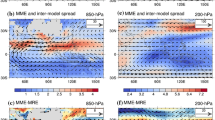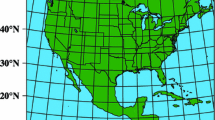Abstract
Precipitation is one of the major challenges in climate modeling. Among various factors, the large-scale atmospheric circulation plays an important role in modulating regional precipitation through dynamic processes that has been widely discussed in previous studies. However, few efforts have been made to investigate the relationship of model abilities to simulate precipitation and vector winds. Such an investigation may help to understand the source of uncertainty of precipitation simulation. Here, we examined the relationship between model performances in simulating precipitation with that in simulating vector winds by using the Coupled Model Intercomparison Project Phase 5 (CMIP5) models. Our results suggest that the model biases/uncertainties in simulating climatological mean precipitation often accompanied by the biases/uncertainties in vector wind fields. Model ability to simulate precipitation is closely related to the ability to simulate vector winds, especially over monsoon regions and the regions with warm and moist advection or high terrains, such as the South Asian and East Asian summer monsoon region, the Alaskan region, the Rocky Mountain, etc. Over these regions, the models with higher horizontal resolution tends to generate improved simulations in both the vector winds and precipitation relative to the models with coarse horizontal resolution. Besides, the model’s ability to simulate vector winds, compared to simulate the zonal wind, meridional wind, and skin temperature, is more closely related to the ability to simulate precipitation. This indicates that it is more meaningful to evaluate the vector winds than the zonal or meridional wind from the perspective of improving regional precipitation simulation.











Similar content being viewed by others
References
Back LE, Bretherton CS (2009) On the relationship between SST gradients, boundary layer winds and convergence over the tropical oceans. J Clim 22:4182–4196. doi:https://doi.org/10.1175/2009JCLI2392.1
Barriopedro D, Gouveia C, Trigo RM et al (2012) The 2009/10 drought in China: possible causes and impacts on vegetation. J Hydrometeorol 13(4):1251–1267. https://doi.org/10.1175/JHM-D-11-074.1
Biasutti M, Sobel AH, Kushnir Y (2006) AGCM precipitation biases in the tropical Atlantic. J Clim 19:935–958. doi:https://doi.org/10.1175/JCLI3673.1
Bishara AJ, Hittner JB (2012) Testing the significance of a correlation with nonnormal data: comparison of Pearson, Spearman, transformation, and resampling approaches. Psychol Methods 17(3):399–417. https://doi.org/10.1037/a0028087
Bishara AJ, Hittner JB (2015) Reducing bias and error in the correlation coefficient due to nonnormality. Educ Psychol Meas 75(5):785–804. https://doi.org/10.1177/0013164414557639
Brown JN, Gupta AS, Brown JR et al (2013) Implications of CMIP3 model biases and uncertainties for climate projections in the western tropical Pacific. Clim Change 119(1):147–161. doi:https://doi.org/10.1007/s10584-012-0603-5
Eyring V, Bony S, Meehl GA, Senior CA, Stevens B, Stouffer RJ, Taylor KE (2016) Overview of the coupled model intercomparison project phase 6 (CMIP6) experimental design and organization. Geosci Model Dev 9:1937–1958. https://doi.org/10.5194/gmd-9-1937-2016
Gadgil S, Sajani S (1998) Monsoon precipitation in the AMIP runs. Clim Dyn 14(9):659–689. https://doi.org/10.1007/s003820050248
Haarsma RJ, Roberts MJ, Luigi VP et al (2016) High resolution model intercomparison project (HighResMIPv1.0) for CMIP6. Geosci Model Dev 9(11):4185–4208. https://doi.org/10.5194/gmd-9-4185-2016
Huang F, Xu Z, Guo W (2019) Evaluating vector winds in the Asian-Australian monsoon region simulated by 37 CMIP5 models. Clim Dyn 53:491–507. https://doi.org/10.1007/s00382-018-4599-z
Kang IS, Jin K, Wang B et al (2002) Intercomparison of the climatological variations of Asian summer monsoon precipitation simulated by 10 GCMs. Clim Dyn 19(5–6):383–395. doi:https://doi.org/10.1007/s00382-002-0245-9
Katz RW, Brown BG (1992) Extreme events in a changing climate: variability is more important than averages. Clim Change 21(3):289–302. https://doi.org/10.1007/BF00139728
Kelley C, Ting M, Seager R et al (2012) Mediterranean precipitation climatology, seasonal cycle, and trend as simulated by CMIP5. Geophys Res Lett. https://doi.org/10.1029/2012GL053416
Kwon MH, Jhun JG, Ha KJ (2007) Decadal change in East Asian summer monsoon circulation in the mid-1990s. Geophys Res Lett. https://doi.org/10.1029/2007GL031977
Lenderink G, Meijgaard EV (2008) Increase in hourly precipitation extremes beyond expectations from temperature. Nat Geosci 1(8):511–514. doi:https://doi.org/10.1038/ngeo262
Lenderink G, Meijgaard EV (2010) Linking increases in hourly precipitation extremes to atmospheric temperature and moisture changes. Environ Res Lett 5(2):025208. https://doi.org/10.1088/1748-9326/5/2/025208
Lintner BR, Adams DK, Schiro KA et al (2017) Relationships among climatological vertical moisture structure, column water vapor, and precipitation over the central Amazon in observations and CMIP5 models: vertical moisture profiles in CMIP5. Geophys Res Lett. https://doi.org/10.1002/2016GL071923
Long SM, Xie SP (2015) Intermodel variations in projected precipitation change over the North Atlantic: sea surface temperature effect. Geophys Res Lett 42(10):4158–4165. https://doi.org/10.1002/2015GL063852
Ma J, Xie SP (2013) Regional patterns of sea surface temperature change: a source of uncertainty in future projections of precipitation and atmospheric circulation. J Clim 26(8):2482–2501. https://doi.org/10.1175/JCLI-D-12-00283.1
Meehl GA, Moss R, Taylor KE et al (2014) Climate model intercomparisons: preparing for the next phase. Eos Trans Am Geophys Union 95(9):77–78. https://doi.org/10.1002/2014EO090001
Nan S, Zhao P, Chen J (2019) Variability of summertime Tibetan tropospheric temperature and associated precipitation anomalies over the central-eastern Sahel. Clim Dyn 52:1819. https://doi.org/10.1007/s00382-018-4246-8
Sobel AH (2007) Simple models of ensemble-averaged precipitation and surface wind, given the SST. In: Schneider T, Sobel AH (eds) The global circulation of the atmosphere. Princeton University Press, Princeton, pp 219–251
Sperber KR, Annamalai H, Kang IS, Kitoh A, Moise A, Turner AG, Wang B, Zhou T (2013) The Asian summer monsoon: an intercomparison of CMIP5 vs. CMIP3 simulations of the late 20th century. Clim Dyn 41:2711–2744. https://doi.org/10.1007/s00382-012-1607-6
Sugiyama M, Shiogama H, Emori S (2010) Precipitation extreme changes exceeding moisture content increases in MIROC and IPCC climate models. Proc Natl Acad Sci 107(2):571–575. https://doi.org/10.1073/pnas.0903186107
Sun C, Yang S (2012) Persistent severe drought in southern China during winter-spring 2011: Large-scale circulation patterns and possible impacting factors. J Geophys Res Atmos. https://doi.org/10.1029/2012JD017500
Taylor KE (2001) Summarizing multiple aspects of model performance in a single diagram. J Geophys Res 106:7183–7192. https://doi.org/10.1029/2000JD900719
Taylor KE, Stouffer RJ, Meehl GA (2012) An overview of CMIP5 and the experimental design. Bull Am Meteorol Soc 93:485–498. https://doi.org/10.1175/BAMS-D-11-00094.1
Turner AG, Slingo JM (2009) Uncertainties in future projections of extreme precipitation in the Indian monsoon region. Atmos Sci Lett 10(3):152–158. https://doi.org/10.1002/asl.223
Twardosz R, Niedźwiedź T, Łupikasza E (2011) The influence of atmospheric circulation on the type of precipitation (Kraków,Southern Poland). Theor Appl Climatol 104(1–2):233–250. https://doi.org/10.1007/s00704-010-0340-5
Vera C, Silvestri G (2009) Precipitation interannual variability in South America from the WCRP-CMIP3 multi-model dataset. Clim Dyn 32(7–8):1003–1014. doi:https://doi.org/10.1007/s00382-009-0534-7
Wang B, Ding Q (2008) Global monsoon: dominant mode of annual variation in the tropics. Dyn Atmos Oceans 44(3–4):0–183. doi:https://doi.org/10.1016/j.dynatmoce.2007.05.002
Wang C, Liang XZ, Samel AN (2011) AMIP GCM simulations of precipitation variability over the Yangtze River Valley. J Clim 24(8):2116–2133. https://doi.org/10.1175/2011JCLI3631.1
Webster PJ, Moore AM, Loschnigg JP et al (1999) Coupled ocean–atmosphere dynamics in the Indian Ocean during 1997–98. Nature 401(6751):356–360. doi:https://doi.org/10.1038/43848
Xie S, Deser C, Vecchi GA et al (2015) Towards predictive understanding of regional climate change. Nat Clim Change 5:921–930. https://doi.org/10.1038/nclimate2689
Xu Z, Han Y, Yang ZL (2019) Dynamical downscaling of regional climate: a review of methods and limitations. Sci China Earth Sci. https://doi.org/10.1007/s11430-018-9261-5
Xu Z, Hou Z, Han Y, Guo W (2016) A diagram for evaluating multiple aspects of model performance in simulating vector fields. Geosci Model Dev 9(12):4365–4380. https://doi.org/10.5194/gmd-9-4365-2016
Zhang X, Lin W, Zhang M (2007) Toward understanding the double Intertropical Convergence Zone pathology in coupled ocean-atmosphere general circulation models. J Geophys Res Atmos. https://doi.org/10.1029/2006JD007878
Zhou T, Turner A, Kinter J et al (2016) Overview of the global monsoons model inter-comparison project (GMMIP). Geosci Model Dev. https://doi.org/10.5194/gmd-2016-69
Zhu J, Liang XZ (2007) Regional climate model simulations of U.S. precipitation and surface air temperature during 1982–2002: interannual variation. J Clim 20(2):218–232. https://doi.org/10.1175/JCLI4129.1
Zhu Y, Wang H, Zhou W et al (2011) Recent changes in the summer precipitation pattern in East China and the background circulation. Clim Dyn 36(7–8):1463–1473. doi:https://doi.org/10.1007/s00382-010-0852-9
Acknowledgements
We acknowledge the World Climate Research Programme’s Working Group on Coupled Modeling, which is responsible for CMIP, and we thank the climate modeling groups for producing and making available their model output. NCEP Reanalysis 2 data provided by the NOAA/OAR/ESRL PSD, Boulder, Colorado, USA, from their Web site at http://www.esrl.noaa.gov/psd/. The study was supported jointly by the National Key Research and Development Program of China (2017YFA0603803, 2018YFA0606004) and the National Science Foundation of China (41675080). This work was also supported by the Jiangsu Collaborative Innovation Center for Climate Change.
Author information
Authors and Affiliations
Corresponding author
Additional information
Publisher's Note
Springer Nature remains neutral with regard to jurisdictional claims in published maps and institutional affiliations.
Rights and permissions
About this article
Cite this article
Huang, F., Xu, Z. & Guo, W. The linkage between CMIP5 climate models’ abilities to simulate precipitation and vector winds. Clim Dyn 54, 4953–4970 (2020). https://doi.org/10.1007/s00382-020-05259-6
Received:
Accepted:
Published:
Issue Date:
DOI: https://doi.org/10.1007/s00382-020-05259-6




